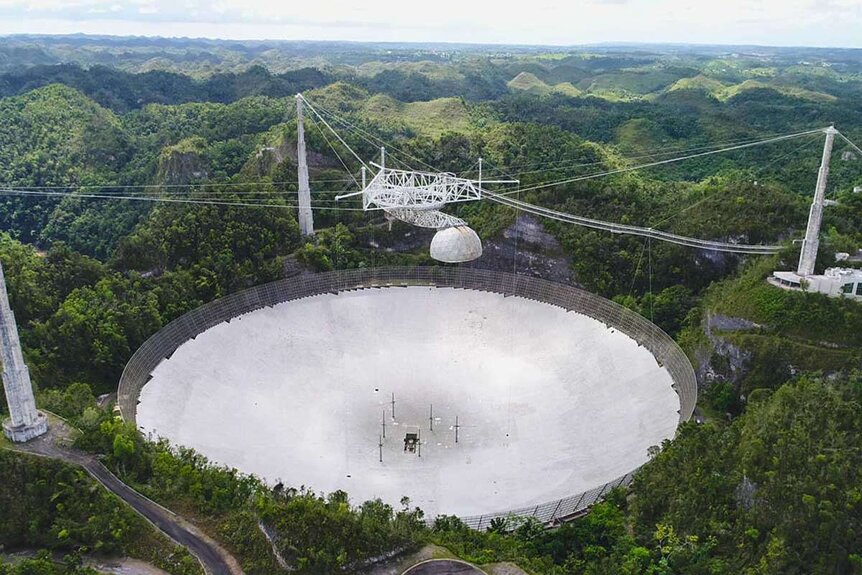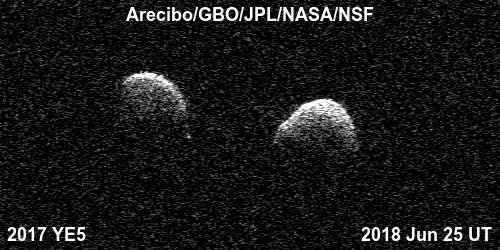Create a free profile to get unlimited access to exclusive videos, sweepstakes, and more!
UPDATED: The giant Arecibo radio telescope to be decommissioned due to damage

UPDATE (1 December 2020): The platform over the dish fell this morning in an uncontrolled collapse. From the photos, it looks like cables from one tower snapped, and the 900-ton platform suspended 150 meters above the giant dish swung over and smashed against a rock cliff. The tops of all three suspension towers were torn off. Parts fell and damaged the dish and several buildings as well. No injuries have been reported.
The damage is extensive, and I don't know if this can be salvaged. I'm awaiting more news and will update ths post as it comes in.
The venerable Arecibo radio telescope, a mammoth 305-meter dish nestled in the forested hills of Puerto Rico, is to be decommissioned after a pair of cables that support a huge platform above the dish broke.
The enormous telescope has been in use since it was completed in 1963, operated by several organizations in cooperation with the US National Science Foundation (NSF). It has been used to study Earth's upper atmosphere, mapping near-Earth asteroids and the Moon, observe distant galaxies, and even send signals to a distant star cluster in an attempt to communicate with any potential civilizations there. The telescope was featured in many movies and TV shows, including the James Bond movie Goldeneye, the brilliant science fiction film Contact, and the Doctor Who episode "The Ambassadors of Death."
The telescope consists of two main structures. The 305-meter dish is composed of nearly 40,000 panels, each about 1 by 3 meters in size. It's supported by steel cables that are strung across a natural concavity in the island's topography (a sinkhole that left behind a large depression). It reflects radio waves from space up into a platform suspended above it that has various radio receivers in it to do different kinds of science. The triangular platform weighs 900 tons and is hung 150 meters above the dish using massive cables strung from three huge towers (one is about 110 meters high, the other two about 80 meters).
In 1997 the facility was updated with a new structure on the platform called the Gregorian dome, which allowed the installation of several new receivers. A dozen auxiliary cables were installed to support the extra weight, attached to the three towers along with the main cables.
On 10 August 2020, one of the auxiliary cables slipped from its post and fell to the ground. The aux cables are made of steel and over 8 centimeters thick, and are very heavy. When it fell it damaged the dish, tearing a 30-meter gash in it, and also damaged several of the panels making up the Gregorian dome. No one was hurt, but this incident provoked NSF to inspect the telescope to see what could be done to repair it.
By September plans were in place to replace the broken aux cable, but then on 6 November one of the main cables supporting the platform broke, catching everyone off guard.
This is a much more serious problem. Each tower has four main cables attached to support the platform, so there are 12 in all. The main cable that broke was attached to the same tower where the aux cable failed. In this case, though, the cable itself snapped.
The main cables are also about 8 cm thick, weigh 7 tons, and are composed of 160 steel wires braided together. An inspection before the main cable snapped showed that 12 of those wires had broken in it, but this was not considered an immediate threat; enough of the other wires were intact that the engineers concluded that there was enough redundancy in the wires that this did not pose an immediate emergency.
Also, after the incident engineers determined the weight it bore was only at 60% of its minimum breaking strength, and it was a calm day (no wind). Apparently the problems in the cable were deeper than suspected. This also raises concerns that the remaining 11 cables may be worn more than previously thought. No one knows if the other cables are damaged or not, or if they can carry the designed load for much longer.
After consideration and an investigation by an engineering team, the NSF concluded that there is no way to fix these problems while still maintaining the safety of any crew who would do the work. Stabilizing or replacing the cable may also accelerate the collapse. The NSF therefore decided to decommission the telescope.
It's not clear what might have damaged the cables. They were very old, and moisture seeping in over the years may have contributed to the problem. Also, Puerto Rico has been battered by hurricanes which strain the structure, and a series of earthquakes near the observatory struck late in 2019 as well. Any or all of these may have been part of the issue.
It's also not clear how the decommissioning will be done just yet. The platform is truly enormous and heavy, and it will take great care to disassemble it properly and safely. However, the alternative is to do nothing, and that will almost certainly lead to an uncontrolled collapse of the platform, which would be catastrophic. There are historical buildings under one tower that need to be preserved, for example. Also, there is wildlife (including endangered species) that thrive under the dish, and those need to be considered as well.
In a press conference, reps for the NSF were very careful to say that they intend to work with the Puerto Rico and scientific communities, and Congress, to continue the observatory itself even as the 305-meter is shut down. In other words, hopes are that a new telescope will be built to replace it. Arecibo provides a lot of economic support for the citizens of the island, as well as STEM support for both teachers and students. Keeping the observatory running with a new 'scope is an important mission.
But it's no small task. Until China built its 500-meter dish in 2016, Arecibo was the largest filled-dish single radio telescope on the planet. Replacing it will be a big project.
I'll note that in 1988, the 100-meter radio telescope in Green Bank West Virginia collapsed. Strain on a metal plate caused it to buckle, sending a cascade of failures through the structure of the then-decades-old 'scope. It was replaced by an enormous fully steerable 100-meter state of the art telescope, so perhaps the same can be done here.
In personal terms, well, I'm bummed. It's obviously a huge blow to radio astronomy, and to such important fields as studying potentially hazardous asteroids. But also, Arecibo has been around my whole life, and was such a versatile and well-loved instrument. I am not a radio astronomer but many of my friends are and have used Arecibo in the past. Losing this facility is just awful.
The desire to study the planet we live on and the Universe around us is one of the noblest aspects of humanity. We have so many ways to do so, so many different and critical senses we employ to understand our environment, both local and very, very distant. It would be a shame to let this one slip away forever. I sincerely hope that a new facility, upgraded and with modern considerations, will rise in its place.































